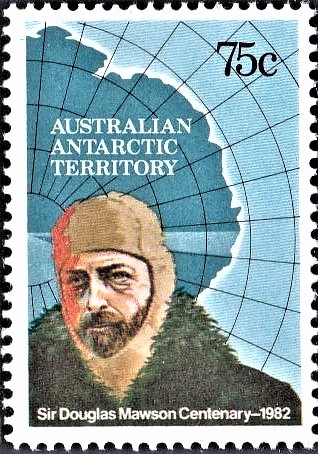
Sir Douglas Mawson
Complete Set of 2 nos of postage stamps on the Birth Centenary of Sir Douglas Mawson, an Australian Antarctic explorer :
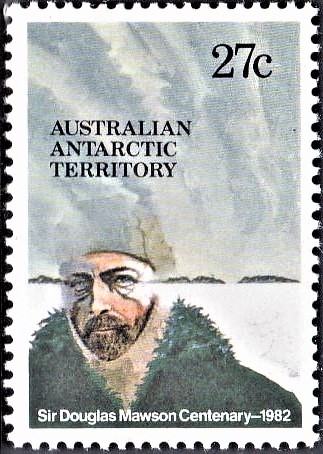

Issued by Australia [Australian Antarctic Territory]
Issued on May 5, 1982
Issued for : Sir Douglas Mawson Centenary
Design : Sir Douglas Mawson, Australia‘s most famous Antarctic explorer, is depicted on the stamps honouring the centenary of his birth, against backgrounds relating to areas of the frozen continent with which his name is so closely associated. On the 27c stamp, a view of the ice plateau inland from Mawson Station stretches to the Masson, David and Casey ranges of the Framnes Mountains on the horizon. A map of the Australian Antarctic Territory forms the background of the 75c stamp.
Designed by : Ray Honisett [Mr. Ray Honisett was born in Perth, Western Australia and studied art at the Perth Technical College. He moved to Melbourne in 1951 where he worked as an illustrator/designer before heading for London in 1955. Mr. Honisett’s first Australian stamp design was a 6c stamp issued in 1970. His 1971 Christmas aerogramme was awarded the 1972 San Gabriele International Prize for Philatelic Art, given annually to the nation which issues the best postal item on a religious subject. In 1979 and again in 1980 he visited the mainland of Antarctica, and on a separate journey in 1980 he visited the Australian Antarctic station at Macquarie Island. Mr. Honisett was employed as a lecturer in illustration at the Royal Melbourne Institute of Technology.]
Type : Stamp, Mint Condition
Colour : Multi colour
Denomination : 27 and 75 cents
Stamp size : 26 mm x 37.5 mm
Perforation : 13¾ x 13¼
Paper : APWH stamp paper
Sheet content : 100 (issued)
Printing process : photolithography on a five–colour Heidelberg Speedmaster press
Printer : Cambec Press, Melbourne
Name : Douglas Mawson
Born on May 5, 1882 at Shipley, West Yorkshire, England, United Kingdom
Died on Oct 14, 1958 at Brighton, South Australia
About :
- Born in Yorkshire on 5 May 1882, Douglas Mawson was two years old when his family emigrated to Australia. Mawson was educated in Sydney, and completed degrees in engineering and science. At Sydney University he encountered the geologist Professor T. W. Edgeworth David, who stimulated his interest in exploration. A portrait of Edgeworth David was included in the 1968 Famous Australians stamp booklet issue.
- Mawson subsequently joined the scientific staff of the 1907-1909 British Antarctic expedition led by Ernest Shackleton. During this first visit to the Antarctic, Mawson was a member of the group including Edgeworth David and Forbes Mackay which made the first ascent of Mt Erebus, an active volcano. Mawson, Edgeworth David and Mackay journeyed on to become the first men to reach the South Magnetic Pole. Using a string attached to the camera trigger, a photograph was taken of the three men with the Union Jack at the approximate mean position of the South Magnetic Pole. The design for definitive AAT stamps issued in 1959 was based on this photograph. The hazardous trek to the Pole and back to the expedition ship ‘Nimrod‘ took some four months. The ‘Nimrod’ was illustrated as part of the Ships of the Antarctic stamp series introduced in 1979.
- Following his experience with the Shackleton expedition, Mawson decided to organise an Australian expedition to explore the area directly south of Australia. The steamship ‘Aurora‘ was purchased with funds provided by Federal and State governments and private donations, and the Australasian Antarctic expedition sailed from Hobart on 2 December 1911. Douglas Mawson, the leader of the expedition, was then aged 29.
- Bases were established en route on Macquarie Island and the Shackleton Ice Shelf in Queen Mary Land. The main base was set up at Commonwealth Bay, in King George V Land. The hut built as winter quarters for the 18 members of the main base party still remains intact, although in need of restoration and regular maintenance.
- Members of the expedition proceeded to map over 1,000 km of coastline, and to collect valuable scientific information. Radio was used to relay messages from Commonwealth Bay to Australia via Macquarie Island, the first transmission from Antarctica.
- While carrying out part of the exploration and survey work of the expedition, Mawson himself very nearly perished. With two companions, B.E.S. Ninnis and Xavier Mertz, Mawson was sledging eastward from Commonwealth Bay. Ninnis was killed when he fell into a crevasse, and Mertz died of a disease now assumed to be Hypervitaminosis A, caused by eating the livers of the sledge dogs, and aggravated by hunger and cold. Mawson, also suffering from disease, with little food and equipment, faced a solitary trek of almost 200 km back to the main base. He arrived back at Commonwealth Bay, after a harrowing journey which included hauling himself out of a crevasse, to find that the ‘Aurora’ had just sailed. Sir Edmund Hillary has described this feat as “probably the greatest story of lone survival in Polar exploration“ [Lennard Bickel. This accursed land. Foreword by Sir Edmund Hillary]. Mawson with six others was left to spend another winter at the Hut. The party was finally relieved m December 1913, and Douglas Mawson was knighted on his return to Australia. A portrait of Sir Douglas was depicted on an AAT postage stamp issued in 1961 to commemorate the 50th anniversary of the 1911-1914 Australasian Antarctic expedition.
- Sir Douglas Mawson returned to Antarctica in 1929 as leader of the British Australian New Zealand Antarctic Research Expedition (BANZARE). During the summers of 1929-1930 and 1930-1931 the BANZARE explored and mapped much new territory south of Australia. British sovereignty was proclaimed at seven localities, and MacRobertson and Princess Elizabeth Lands were discovered and named.
- Among other activities in later years, Sir Douglas remained involved in Antarctic affairs, particularly the setting up of ANARE, the Australian National Antarctic Research Expedition. The first permanent ANARE station on the Antarctic mainland was named Mawson, in his honour. The Mawson Institute for Polar Research established at Adelaide University in 1959 commemorated Douglas Mawson‘s long connection with the University, as Professor of Geology from 1920 until his retirement in 1952. He died in Adelaide on 14 October 1958, and was accorded a State funeral.


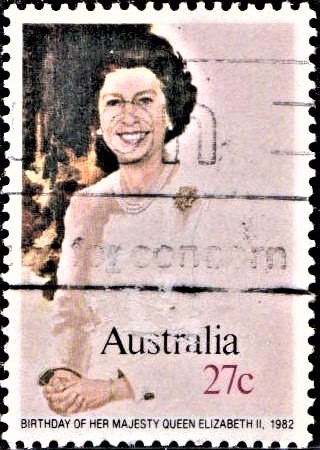



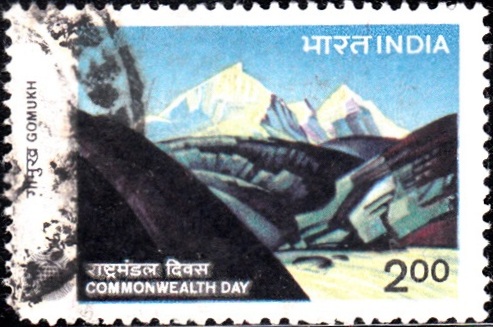
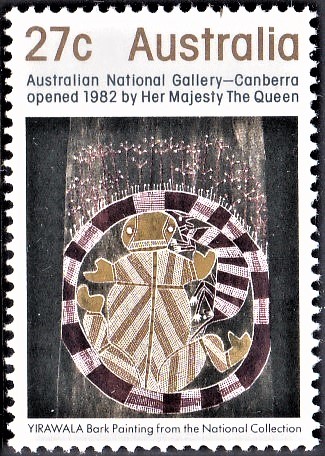
Good Morning
My name is Sean Dennis and I’m originally from Otley in Yorkshire England but I have lived and worked in London and Brighton most of my adult life. Im just doing some research on Sir Douglas Mawson as he was a cousin of mine. I’m heading to Australia next month and hopefully will visit Brighton when I’m there.
Good Evening
It’s really wonderful to have you here. Please share more of your stories and have a great visit of Australia.
Thanks and Regards,
iStampGallery
[…] Stamp Week 1976, Richard Byrd for the 50th anniversary of the first flight over the South Pole, and Sir Douglas Mawson for the 1982 AAT commemorative stamp. Mr. Honisett is employed as a lecturer in illustration at […]